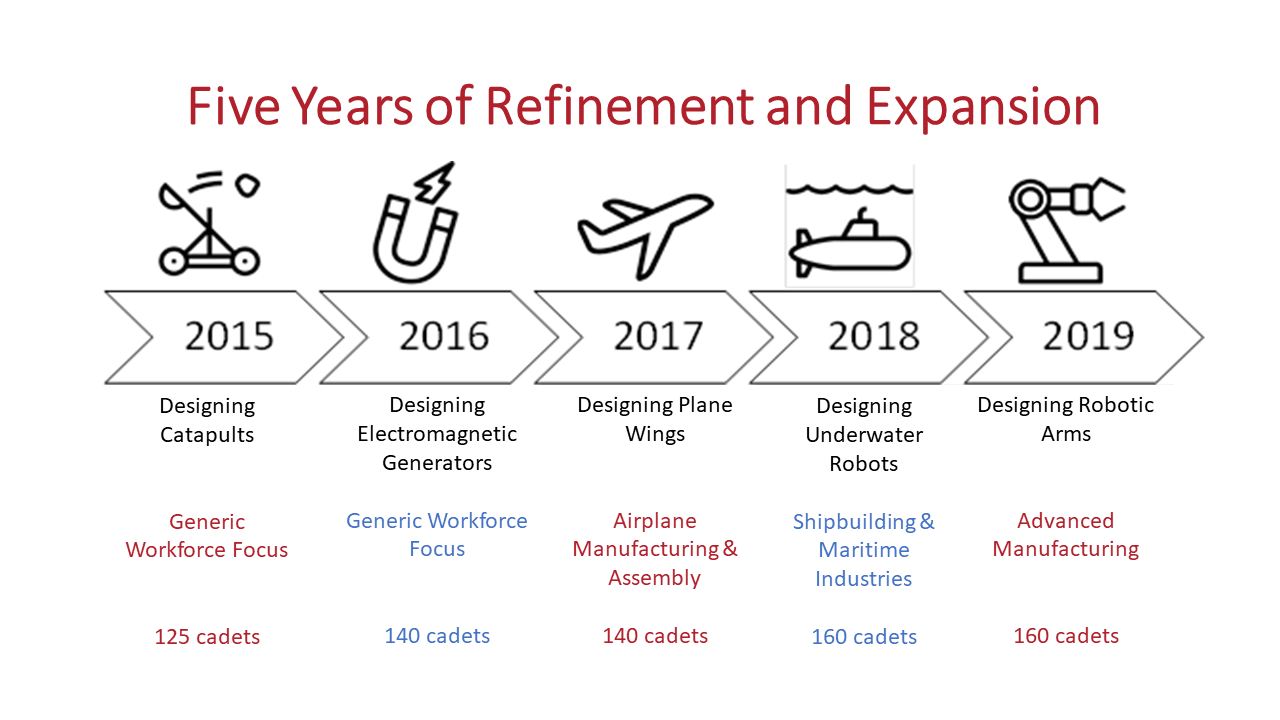JROTC STEM LEADERSHIP ACADEMY
The goal of the JROTC STEM Leadership Academy, a residential academy, is to expose and engage a unique population of Mobile high school students in STEM content, skills, and fields of study.
The STEM Academy will give Cadets the opportunity to see STEM content and technology in action as they interact with scientists and engineers designing and innovating solutions to area industry and community problems. Cadets will observe first-hand the broad range of STEM-dependent jobs right here in Mobile and participate as part of a Cadet-team to create, test, and improve their own solutions to an STEM-focused engineering design challenge.
Academy Summary
The purpose of the six-day residential JROTC STEM Leadership Academy is to engage a unique population of high school students, 9th and 10th grade JROTC cadets, in STEM content, skills, and fields of study needed by business and industry today. The Academy is designed to increase awareness of good-paying STEM career opportunities in our area for Mobile?s youth and what it takes to secure these jobs. The Academy integrates five types of activities to ultimately increase the number of Mobile JROTC cadets interested in and prepared for the technical and other STEM dependent jobs that are in high demand in our area.
- Teambuilding, Communication, and Leadership Development Activities
- Team STEM Design Challenges
- Industry Site Visits and Guest Speakers
- University, College, and Educational Field Trips
- JROTC Cadet Leadership Challenge Activities
Academy Design & Framework
The STEM Academy was conceived as three distinct, interconnected layers to represent the hierarchical structure of the key components: (1) JROTC, (2) STEM Learning, and (3) Workforce Experiences. The foundation of the model lies in the JROTC character education curriculum and culture. Students who participate in the STEM local colleges, area industries, and evening motivational guest speakers, reinforce the JROTC character traits and STEM learning. These workforce experiences are designed to engage students in vicarious STEM learning, meaning students learn about STEM and build a STEM identity by observing expert level STEM professionals at work. Students come with differing levels of the character traits, but all have been exposed to the JROTC culture and curriculum for at least one school year prior to the summer experience. The inputs and outcomes of this component are equivalent to the traditional JCLC camp. The STEM .
In 2018, the Mobile County Public School System was awarded approximately one million dollars from the National Science Foundation's ITEST (Innovative Technology Experiences for Students and Teachers) to study the short-term and long-term impacts of participation in the program. This webpage is dedicated to showcasing the Academy, the curriculum developed for the Academy, and the resulting impacts (short-term and long-term) on high school students. This material is based upon work supported by the National Science Foundation under Grant No.1759430.
Learning component consists of a series of STEM experiences woven through the traditional summer JROTC activities. These STEM lessons extend mathematics and science content knowledge and provide first hand experience with STEM technology and challenges in order to build interest and efficacy around STEM. Workforce Experiences, such
as site visits to local colleges, area industries, and evening motivational guest speakers, reinforce the JROTC character traits and STEM learning. These workforce experiences are designed to engage students in vicarious STEM learning, meaning students learn about STEM and build a STEM identity by observing expert level STEM professionals at work. The research team also put together a logic model to support evaluation of the short-term and long-term impacts of the program. This logic model can be used as a guiding heuristic for other JROTC programs to replicate a community-specific Academy. The logic model includes the necessary inputs, activities, and outputs that will logically lead to the expected outcomes.You can download the complete logic model as well as a blank logic model worksheet here. Additional resources are also provided below to support the planning and replication of the Academy.
Academy Short-Term & Long-Term Impacts
Since its inception in 2015, the JROTC STEM Leadership Academy has shown positive impacts in students' knowledge of mathematics and science content as well as the engineering design process and learning from failure. While the real-world connection (e.g. aerospace, maritime, or advanced manufacturing) changes each year, and the STEM content changes each year, the Academy has shown increased knowledge of math/science content, increased confidence and awareness of teamwork and leadership, and consistently high levels of satisfaction. Executive summaries the latest evalutions are available below for download. Full evaluation reports can be provided upon request.

With funds from the National Science Foundation ITEST grant (ID# 1759430), the research team began a three-year longitudinal study of the impact of the week-long Academy experience compared to a control group of cadets who participated in a traditional JROTC summer camp. This project is guided by three major research questions:
RQ1: What are the unique and synergistic contributions of the (1) JROTC program, (2) STEM learning, and (3) workforce experiences, when implemented in a residential summer program, to broadening STEM career interest, preparation, and aspirations, especially for students from underrepresented populations?
RQ2: What are the short-term (immediately after intervention) interest, preparation, and aspirational shifts that occur in student cadets as the result of the blended JROTC and STEM intervention?
RQ3: What are the long-term (up to 3 years after intervention) interest, preparation, and aspirational shifts that occur in student cadets as the result of the blended JROTC and STEM intervention?
Findings from the research project from 2018-2019 were presented at the 2021 ASEE Virtual Annual Conference. Analysis of the longtitudinal data is underway and will be published upon completiong of the ITEST project in Fall 2022.



